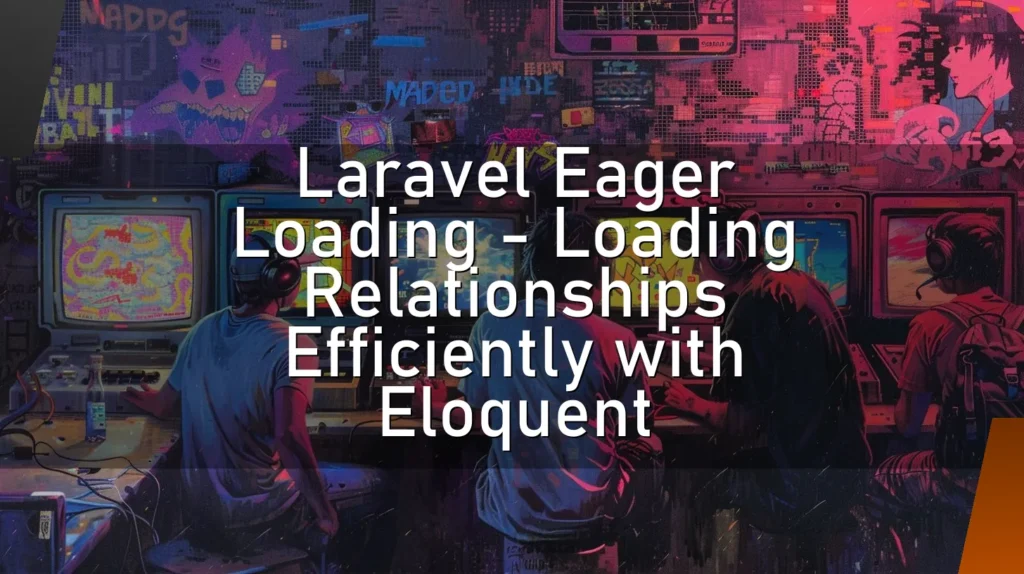👋 Introduction
Ah, Laravel! The darling of the PHP world, the Beyoncé of web frameworks. Whether you’re a seasoned developer or a newbie who’s just realized that PHP isn’t some sort of exotic insurance policy, Laravel has something to offer. Today, we’re diving into one of its most delightful features: Eager Loading. If you’ve ever felt like your app’s performance is dragging slower than a snail on a lazy Sunday, eager loading might just be your knight in shining armor. So, buckle up, buttercup! This is going to be both enlightening and entertaining.
💡 Common Uses
Eager loading is typically used when you have database relationships that need to be fetched together. For instance, imagine you have a blog (now imagine you actually update it regularly). You might have a Post model and a related Comment model. Without eager loading, fetching a post and its comments could result in what’s infamously known as the N+1 query problem. In layman’s terms, it’s like making a separate trip to the grocery store for each item on your shopping list. Ain’t nobody got time for that! 😂
Another common scenario is when you have multiple relationships to load. Let’s say you have users who have posts, and those posts have comments, and those comments are written by other users. Without eager loading, you’re basically trapped in an infinite loop of queries, much like that one time you promised to watch just one episode on Netflix.
👨💻 How a Nerd Would Describe It
Eager loading in Laravel is the process of querying multiple related models with a single, highly optimized SQL query. This is achieved using Eloquent’s with method, which informs the ORM to fetch the related records in the same database call, thereby reducing the number of queries executed and enhancing the application’s performance. It’s a strategy to combat the N+1 problem, where ‘N’ represents the number of queries executed to retrieve associated records.
In technical terms, when you apply eager loading, Eloquent constructs a join statement or additional select statements to retrieve the related data. This ensures that the loaded relationships are already hydrated when the main model is returned, thus preventing additional database hits.
🚀 Concrete, Crystal Clear Explanation
Still here? Good! Let’s break it down. Suppose you have a Post model and each post can have multiple Comment models. Without eager loading, fetching a post and its comments would mean you first fetch the post and then loop through each post to fetch its comments individually. This is like going to IKEA and realizing that each screw for your flat-packed furniture is in a different aisle. 😱
Using eager loading, you tell Laravel, “Hey, I need the post and its comments, and I need them now!” So instead of performing multiple queries, you just do it in one fell swoop. It’s like a magical shopping cart that collects all screws, Allen wrenches, and those confusing instruction booklets in one go. 🛒✨
Here’s a quick example:
// Without Eager Loading
$posts = Post::all();
foreach ($posts as $post) {
// This will run a separate query for each post to get its comments
$comments = $post->comments;
}
// With Eager Loading
$posts = Post::with('comments')->get();In the second example, we use the with method to tell Eloquent to retrieve the related comments in the same query, thus significantly reducing the number of queries executed.
🚤 Golden Nuggets: Simple, Short Explanation
- Eager Loading: Load relationships in advance to avoid multiple database queries.
- N+1 Problem: A performance issue where ‘N’ queries are executed to load related data.
- Use
withMethod: Addwith('relationship')to your Eloquent queries to load related data.
🔍 Detailed Analysis
When you use eager loading, Laravel generates a SQL query that includes a JOIN or an IN clause to fetch all relevant data in one go. This mitigates the performance hit associated with repeated queries. Imagine you’re hosting a dinner party and you realize halfway through that you’ve run out of wine. Without eager loading, you’d keep making individual trips to the store for each bottle. With eager loading, you bring a truckload of wine in one trip. 🥳
However, eager loading isn’t without its pitfalls. Over-eager loading is a thing. Load too many relationships or deeply nested relationships, and you might find yourself in a situation where your single query is more like a black hole, sucking all the performance out of your app. Always balance between under and over-eager loading because either extreme can be detrimental.
👍 Dos: Correct Usage
- Use
withmethod: When you know you’ll need related data. - Be Selective: Only load relationships you need for that specific request.
- Chain Eager Loads: You can even chain eager loads to load nested relationships like so:
Post::with('comments.author')->get();.
🥇 Best Practices
- Selective Loading: Always specify only the relationships you actually need.
- Conditional Eager Loading: Use conditional loading if parts of your application only sometimes need related data.
- Use
load()Method: When you have an already retrieved collection and decide later that you need related data.
$posts = Post::all();
$posts->load('comments');This is especially handy when you want to defer the decision to load relationships until after the initial query.
🛑 Don’ts: Wrong Usage
- Don’t Load Everything: Resist the urge to load all possible relationships just in case. This can lead to performance issues.
- Avoid Deep Nesting: Loading deeply nested relationships in one go can create monstrously complex queries.
- Don’t Forget
Preload: If you conditionally need related data, use conditional loading or theloadmethod instead of bloating your initial query.
➕ Advantages
- Performance Gains: Fewer database queries lead to faster performance.
- Simplified Code: Less looping and fewer conditional queries in your codebase.
- Reduced Latency: Your app becomes more responsive because it spends less time querying the database.
➖ Disadvantages
- Complex Queries: Overloading with too many relationships can create complex SQL queries that are hard to debug.
- Memory Usage: Fetching a lot of related data in one go can consume more memory.
- Maintenance: Over time, as your application grows, you may need to constantly fine-tune which relationships are eagerly loaded.
📦 Related Topics
- Lazy Loading: The opposite of eager loading, where relationships are loaded as they are accessed.
- Query Scopes: Custom query logic that can be reused.
- Database Indexing: Optimize your database queries further by indexing your tables.
- ORM (Object-Relational Mapping): Eloquent is Laravel’s ORM and a crucial part of working with databases in Laravel.
⁉️ FAQ
Q: When should I use eager loading?
A: Use it when you know you’ll need related models and want to avoid the N+1 problem.
Q: Can I use eager loading for nested relationships?
A: Absolutely! You can chain them like so: Post::with('comments.author')->get();.
Q: What’s the difference between eager and lazy loading?
A: Eager loading fetches related data in advance, while lazy loading fetches it on demand.
Q: Is there a limit to how many relationships I can eagerly load?
A: No formal limit, but be cautious of performance and memory usage.
👌 Conclusion
Eager loading is like the Swiss Army knife of Laravel performance optimization. It’s one of those tools that, once you understand how to use it correctly, can significantly boost your app’s performance. But remember, with great power comes great responsibility. Use eager loading wisely, and you’ll have a snappy, responsive application that even your grandmother would be proud of. 🏆
So go ahead, dive into your Laravel codebase and start eager loading those relationships. Your database will thank you, your users will love you, and who knows, you might even get a few more comments on that blog of yours! 🎉💻





